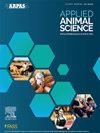Effects of postweaning management of beef × dairy hybrid steers on performance, efficiency, and carcass characteristics
IF 1.5
Q3 AGRICULTURE, DAIRY & ANIMAL SCIENCE
引用次数: 0
Abstract
Objective
Our objective was to determine the per- formance, efficiency, and carcass quality in beef × dairy crossbred steers that were either placed directly on feed following weaning (FIN) or following an average stocker grazing period of 217 d (GRW/FIN).
Materials and Methods
Beef × dairy hybrid steers (n = 475) from Land O’Lakes Calf Milk Research Facility (Gray Summit, MO) at 12 wk of age were transported to the Willard Sparks Beef Research Center (WSBRC; Still- water, OK) in groups (n = 8) of 57 to 72 steers. Steers in the first group to arrive were allocated to either GRW/FIN or FIN treatment by BW, previous treatment, and breed of sire for each finishing treatment. Subsequent groups were all assigned either to FIN or GRW/FIN finishing treatments. Paired groups of FIN and GRW/FIN with overlapping feeding dates were considered a random block (n = 4) for statistical analysis. At WSBRC, steers were sorted by BW within sire breed and preweaning treatment into pens of 4 to 5 steers each and finished to a targeted 1.3 cm backfat. Data were analyzed using the Mixed pro- cedure of SAS 9.4 (SAS Institute Inc., Cary, NC), with pen within block as the experimental unit.
Results and Discussion
Steers in GRW/FIN had greater (P < 0.01) BW and hot carcass weight while re- quiring fewer (P < 0.01) days on feed compared with FIN steers but were 75 d older at harvest. Average daily gain and feed intake were greater but G:F was lesser (P < 0.01) for GRW/FIN. Steers in GRW/FIN had a greater (P ≤ 0.03) ribeye area, marbling score, and percentage of USDA High Choice and Prime carcasses and fewer USDA Select carcasses (P < 0.05) compared with FIN steers.
Implications and Applications
Grazing beef × dairy crossbred steers before finishing increased animal performance and improved carcass characteristics but also increased daily feed intake compared with calves placed directly on feed. Beef × dairy crossbred calves offer a viable alternative to straight-bred dairy calves, but it is necessary to determine proper management strategies for these calves.
断奶后管理对牛×乳杂交阉牛生产性能、效率和胴体特性的影响
我们的目的是确定断奶后直接饲喂或平均放牧期217 d (GRW/FIN)后直接饲喂牛乳杂交阉牛的生产性能、效率和胴体质量。材料与方法来自Land O 'Lakes小牛奶研究机构(Gray Summit, MO)的12周龄的牛乳杂交阉牛(n = 475)运往Willard Sparks牛肉研究中心(WSBRC;静止的水,好吧)在57到72头牛的组(n = 8)。第一组到达的阉牛根据体重、以前的处理和每个肥育处理的父系品种,被分配到GRW/FIN或FIN处理。后续各组均分为FIN或GRW/FIN育肥处理。将饲喂日期重叠的FIN和GRW/FIN配对组作为随机组(n = 4)进行统计分析。在WSBRC,根据母猪种内的体重和断奶前处理将阉牛分为4 - 5头的栏,并最终达到目标1.3厘米的背膘。数据分析采用SAS 9.4 (SAS Institute Inc., Cary, NC)的混合程序,以块内笔为实验单元。结果和讨论:GRW/FIN患者P <;0.01)体重和热胴体重,而对(P <;在收获时,它们比原鳍肉牛大75 d。平均日增重和采食量较大,但G:F较小(P <;GRW/FIN为0.01)。GRW/FIN组的肉牛肋眼面积、大理石纹评分、USDA优质和优质胴体比例较大(P≤0.03),USDA优质胴体比例较小(P <;0.05)。意义与应用育肥期前放牧牛乳杂交阉牛可提高动物生产性能,改善胴体特性,但与直接饲喂相比,日采食量也有所增加。牛乳杂交犊牛是替代纯种犊牛的可行选择,但有必要确定适当的管理策略。
本文章由计算机程序翻译,如有差异,请以英文原文为准。
求助全文
约1分钟内获得全文
求助全文

 求助内容:
求助内容: 应助结果提醒方式:
应助结果提醒方式:


